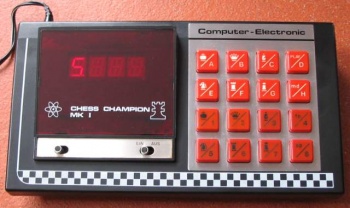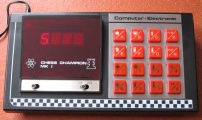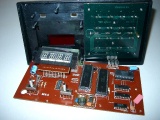Novag Chess Champion MK I
| Novag Chess Champion MK I | |||
|---|---|---|---|

|
|||
| Hersteller | Novag | ||
| Markteinführung | 1978 | ||
| CElo | 733 | ||
| Programmierer | Goodrich, David B. & Associates | ||
| Prozessor | Takt | RAM | ROM |
| F8 (Fairchild 3850) | 2 / 3 MHz | 256 Byte | 2 KB |
| Rechentiefe | BT-2450 | BT-2630 | Colditz |
| Bibliothek | --- | ||
| Display | 4-stellige 7-Segment LED Anzeige | ||
| Spielstufen | 6 | ||
| Zugeingabe | Tastatur | ||
| Zugausgabe | Display | ||
| Einführungspreis | 248 DM (125 Euro) | ||
| Prozessortyp | 8 Bit | ||
| Stromversorgung | 9V / 300mA | ||
| Maße | 22 x 12 x 4 cm | ||
| Verwandt | CompuChess | ||
| Sonstiges | |||
| The Chess Champion MK I was Novag's first dedicated chess computer. The program was a pirate copy of the ROM in the CompuChess. | |||
| Infos |
|---|
Es gab 2 verschiedene Ausführungen des Geräts, die erste Version hatte wie der CompuChess 2 MHz. Später kam eine Version mit 3 MHz auf den Markt, die mit "Quick-Respone" beworben wurde, diese Version wurde auch unter dem Label "VIDEOMASTER Chess Champion" vermarktet.
mk1.c Driver file to handle emulation of the Novag/Videomaster Chess Champion MK 1 by PeT mess@utanet.at 2000,2001. Minor updates by Wilbert Pol - 2007 Hardware descriptions: - An F8 3850 CPU accompanied by a 3853 memory interface Variations seen: - MOSTEK MK 3853N 7915 Philippines ( static memory interface for f8) - MOSTEK MK 3850N-3 7917 Philipines (fairchild f8 cpu) - 3850PK F7901 SINGAPORE (Fairchild F8 CPU) - 3853PK F7851 SINGAPORE (static memory interface for F8) - 2KB 2316 compatible ROM Variations seen: - Signetics 7916E C48091 82S210-1 COPYRIGHT - RO-3-8316A 8316A-4480 7904 TAIWAN - 2 x 2111 256x4 SRAM to provide 256 bytes of RAM Variations seen: - AM9111 BPC / P2111A-4 7851 - 16 keys placed in a 4 x 4 matrix - Power on switch - L/S switch. This switch is directly tied to the RESET pin of the F8 CPU. This allows the user to reset the CPU without destroying the RAM contents. - A 4 character 11 segment digit display using a 15 pin interface. Of the 15 pins 3 pins are not connected, so three segments are never used and this leaves a standard 7 segments display with a dot in the lower right. - The digit display is driven by two other components: - SN75492N MALAYSIA 7840B - ULN2033A 7847 - Hardware addressing is controlled by a NBF4001AE. - Unknown if there is a speaker. TODO: - Figure out exact clock frequency |
Partiebeispiele






